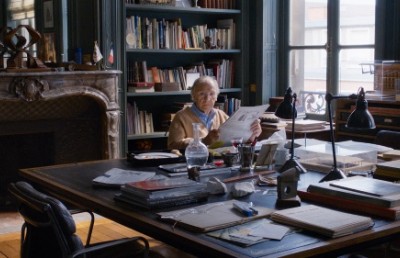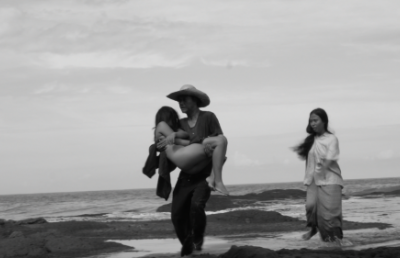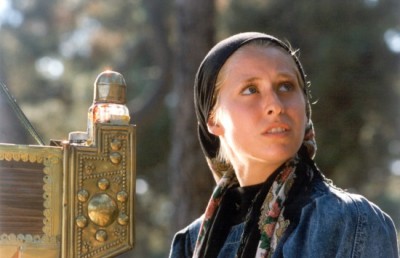The Existentialist Realism of New Russian Cinema: Notes From the St. Petersburg’s FIPRESCI Colloquium, November 2017
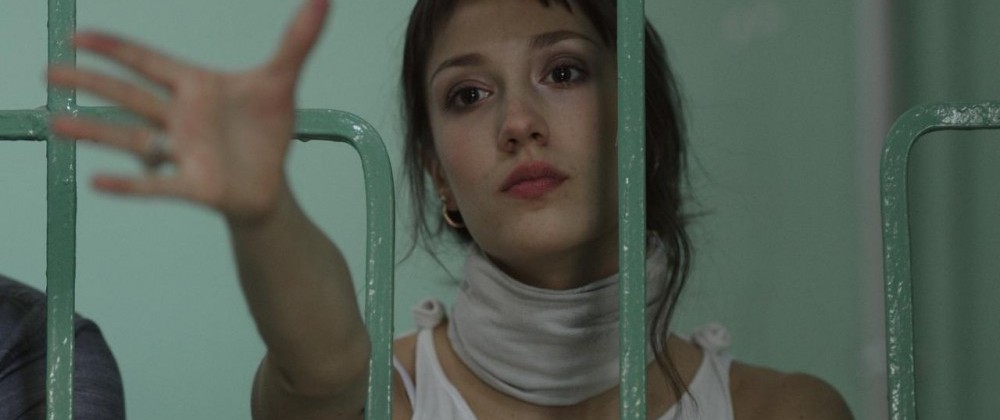
I must find a truth that is true for me . . . the idea for which I can live or die.
Søren Kierkegaard 1
It is not easy to write about the current state of Russian cinema in light of news about problems with distribution of allegedly controversial films — first of Russia’s very own Matilde (Матилда, Aleksey Uchitel, 2017), and more recently – of the UK/French production The Death of Stalin (2017, Armando Iannucci, France/ UK/ Belgium). In addition to bringing back memories of the closely watched Soviet cinematic past, and on the backdrop of the extant unfavourable image of Russian politics in the West, such cinematic news makes it even more difficult to focus ‘without prejudice’ on the works, produced over the last year or so in Russia. And make all the more relevant Joseph Brodsky’s famous dictum that in Russia a poet is more than a poet – and a film is more than just an entertainment, for it is expected, sometimes unfairly so – to participate one way or another in ongoing socio-political and cultural polemics. Inevitably, the present and the future of post-Soviet Russian cinema, more particularly its financing and its interaction with the viewers – and with the powers-that-be – have become an intrinsic part of this polemics. Clearly, most Russian films have been relying increasingly on funds, provided by various state structures, among the most generous of which is Russian television. Consequently, the success of the vast number of TV series produced has tilted the balance from the predominance of art-cinema oriented lore during the 1990s to viewer-oriented works, true to the Soviet tradition of art for the masses. 2 Therefore the twelve very different films, shown within the framework of the FIPRESCI Colloquium —held in St. Petersburg (Nov 13-15) ) within the framework of the Biannual Cultural Forum, and under the aegis of Klaus Eder, FIPRESCI Secretary General, and Andrey Plakhov, FIPRESCI Honorary President— revealed this new reality of Russian cinema, featuring six mainstream and six art cinema works.
Most interestingly, the selection bespoke of interest to inward-looking, self-reflexive characters rather than keeping up with the social – or rather socio-political – agenda as has been traditionally expected from the postcommunist cinema. In other words, with its insistence on subjectivity and authenticity, on moral choice and commitment and the inevitably ensuing dread and anxiety in the face of nothingness (as J.-P. Sartre had it) – the general vocation of current Russia cinema could be defined as existentialist, best captured in the above quote by Søren Kierkegaard, the founder of Existentialism as a philosophy and a way of life.
In post-Soviet Russian cinema, the interest towards introverted loners emerged simultaneously with the newly-found passion for auteur reinvention of melodrama, and especially for creation of new genres like the Mafiosi Thriller and the Social Horror in the 1990 and the early 2000s. 3
In his ground-breaking film Brother (Брат, 1996) – followed by the less successful Brother 2 (Брат 2, 2000) – Alexey Balabanov (1959-2013) introduced a new type of hero – a killer for hire, plagued by existential doubts, yet ethically motivated to set things right for the down-and-outs. This type of character, associated with the tragically deceased Sergey Bodrov, Jr (1971-2002) – who continued the cycle by directing and starring in Sisters (Сёстры, 2001) – harks back to Jean-Pierre Melville’s eccentric gangsters, whose essence was ingeniously captured by Alain Delon in Le Samurai (The Samurai, 1967). Thus the characters of Bodrov Jr were a unique cross-breed between American gangsters, film noir anti-heroes, and Albert Camus’s personages. In fact, Balabanov continued what another fellow St. Petersburg director, Aleksandr Rogozhkin, had already started with his eccentric comedies Living with an Idiot (Жизнь с идиотом, 1993) and the Peculiarities of the National Hunt (Oсобености национальной охотьi, 1995), which offered a palatable attempt at revealing the shadow sides of the collective Russian self (or soul) from the outside, through the external gaze of an ‘other’. 4
Thus it is difficult to imagine a more appropriate launching of the Colloquium, which acknowledges both the St. Petersburg film studio, known also as Lenfilm, and the work of one of its most talented post-Soviet directors, than the screening of Balabanov’s remastered Of Men and Freaks (Про уродов и людей, 1998). The film, “[d]esigned every bit as a Western horror film, it elegantly employs the cultural symbols of pre-revolutionary St. Petersburg — symbolist paintings, art nouveau architecture, and special light effects”. 5
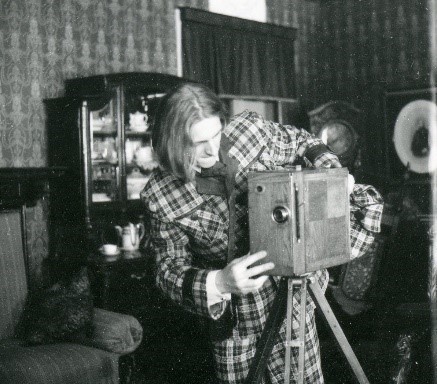
Of Freaks and Men
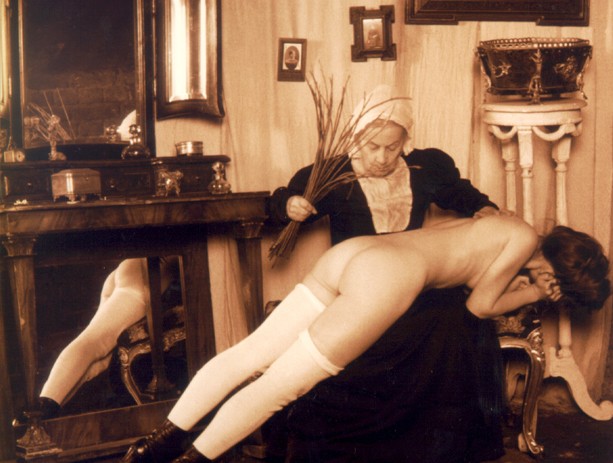
Of Freaks and Men
Moreover, as mentioned elsewhere, in addition to the Mafiosi Thriller, Balabanov launched the Social Horror genre with Of Men and Freaks, which is an unusually powerful insight into profane underbelly of St. Petersburg ‘Silver Age’ obsession with the sacred and the divine. Balabanov thus
[e]xhaustively drags the high canon of Russian cultural values down to cinema level, enlisting the music of Prokofiev and Musorgsky, and the scrupulous reconstruction of decadent symbolism and necrophiliac melodramatism. The ominous contrast between divine music and corrupt reality creates titillation mixed with a sense of terror and guilt at the uncanny recognition of forbidden pleasures, ‘familiar and old-established in the mind’ yet ‘alienated (…) through the process of repression,’ imposed by the long years of Tsarist-Clerical and then Soviet censorship. 6
Mainstream Genre Paradigms and Existentialist Themes
Eloquent proof of the enduring confluence between existentialism and genre cinema in times of crises, was unexpectedly garnered by the three high profile mainstream films, shown at the Colloquium. Indeed, according to the contemporary Russian writer Evgenyi Vodolazkin – yet another famous St. Petersburg citizen –there are daytime and nighttime eras of history, with the former ones – like the Renaissance and Modernity – encouraging collective endeavours, while the latter – like the Medieval era to which he compares our times – stimulating withdrawal from the world, and fostering personal growth. 7 In Matilde, for example, Uchitel portrays Nicholas II as a young man, caught between two beautiful women – the prima ballerina of the Imperial theatre Matilda Kshesinskaya and his fiancée, Alexandra Feodorovna (nee Alix of Hesse) – until his mother, the Empress, steers his preferences in the ‘right’ direction. Out of place and out of time, Nicholas’ drama evolves at the height of the first major crisis of European 20th century modernity, which would have required a diametrically opposite personality at the helm of the Russian Empire. In the long historical shadow of the bloody turmoil that would soon ensue, Uchitel’s film offers an unexpectedly decadent rendition of the famous slogan that the personal is always already political. Showing the emperor not as a tragic victim of historical circumstance – but as a man of weak and noncommittal nature, an introverted, sentimental, and family centered one –has probably triggered on an unconscious level a much more serious ire 8 in current Russian monarchists rather than the preliminary media speculations about the nature of his sexual escapades with Kshesinskaya, shown on screen. Which, by the way, turned out to be quite timid!
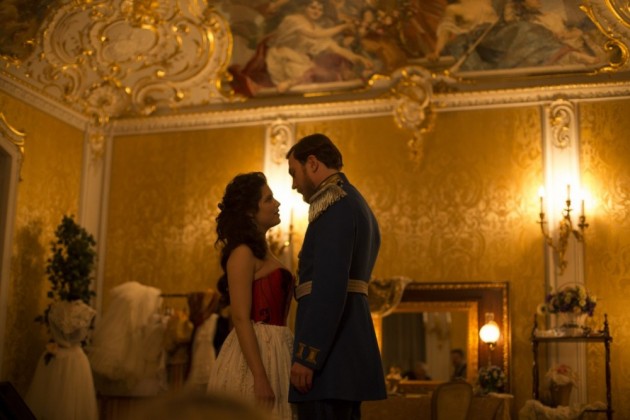
Mathilde
The other two multi-million rubbles works, shown at the Colloquium – Fedor Bondarchuk’s Attraction (Притяжение) 9 and Klim Shipenko’ Salyut-7 (Салют 7) 10 – contrary to conventional genre expectations, fostered by the Hollywood Sci-Fi/ Catastrophe/Romance, and Historical Action – also shift the accent from the public to the personal. Besides, both films navigate more than successfully the thin blue line, separating the Hollywood Hero beyond fear and reproach (in Attraction it is a Heroine) from the Positive Heroes and Heroines, populating Soviet cinema from the times of Vassiliev Brother’s Chapaev (1934) – considered the first Socialist Realist film avant la mot — through the rapid waning of the openly ideological Soviet cinema in the late 1980s. 11 Which goes a long way in explaining why Russian directors feel so at home with the Hollywood genre conventions, yet take the liberties of spicing them up with irony and self-irony. Nonetheless, even in the predictable narratives of Attraction and Salyut 7, the existential moment of the personal moral choice and responsibility is crucial for the climax and resolution of the conflict.
Thus the heroine of Attraction Yulia (Irina Starshenbaum) – a high-school student from Moscow circa 2017 – is easily identifiable with the bold female characters from the Soviet films, who mature into selfless, but also much more considerate personalities than their male counterparts. Indeed, Yulia’s conservative, albeit dotting father, colonel Lebedev (Oleg Menshikov), is firmly convinced that the crash landing of an alien space craft in the outskirts of Moscow, which has caused a lot of damage and loss of life, is actually an act of war on behalf of NATO, and is readying himself and his unit to respond in kind. Moreover, her boy-friend Artem (Aleksandre Petrov) – who initially comes through as a rough around the edges, but otherwise good and overprotective guy – suffers a negative transformation, triggered by the widespread death and havoc, and goes on to helm a para-military xenophobic movement, called The Earth for the Earthlings.
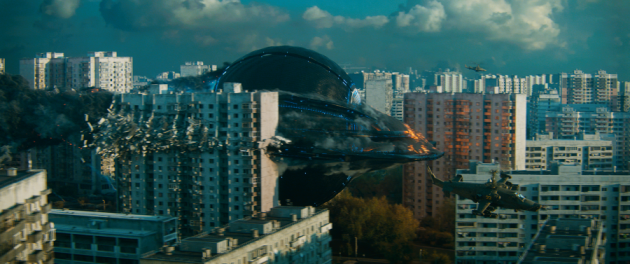
Attraction
Bondarchuk has already demonstrated a taste for the military blockbuster with his breakthrough Afghan epic The 9th Company (9 рота, 2005), whose success he was to repeat on a larger scale with his international hit Stalingrad (2013), devoted to the 70th anniversary of the eponymous decisive battle against the Nazis. He has also affirmed his passion for Science Fiction with the anti-utopian duology Dark Planet (Обитаемый остров, 2008) and Dark Planet: Rebellion (Обитаемый остров: Схватка, 2009), based on the eponymous novel by the Strugatsky Brothers (who wrote Roadside Picnic, 1971, source novel for Tarkovsky’s Stalker). The duology looks uncannily like a prequel to Attraction: the Dark Planet spaceship commander Maxim, an earthling from the 22nd century, crash lands on an alien planet, plagued by serious ecological and social problems, suspiciously remindful of the Earth in Attraction. The major difference is that while the belligerent Maxim leads the docile and brainwashed Dark Planetarians – called contemptuously ‘degenerates’ by their powerful and invisible masters – into an eventually successful rebellion, in Attraction, the alien spaceship commander Haekon (Rinal Mukhametov) is a pacifist, who firmly believes in nonviolence, ensured by wise technology. Intrigued by his unusual behaviour and unwavering humanism, Yulia undergoes a positive evolution, which parallels the binding transformation of Soviet-era characters under duress, but also the self-sacrificial transformation of Hollywood heroes in similar circumstances. 12
Unlike Yulia, Artem remains blind to Haekon’s noble ideas, and leads the ‘earthlings’ into a rebellion, which predictably ends up in a bloody defeat. While it is easy to detect political allusions to the series of civilian unrests that have taken place within the post-Soviet space over the last ten years or so, the film also clearly points to Artem’s negative apprenticeship, sustained by resentment and anger. This contrast plays up Yulia’s agency in overcoming her own resentment, caused by the loss of her best friend in the crash, and motivates her determination to save Haekon from harassment and death in the hands of the jealous Artem and his gang. In turn, Haekon sacrifices his life to save hers, as he realizes that Yulia would be a most deserving citizen of his home planet which, while identical with the Earth in terms of biosphere, is much more advanced technologically and, most importantly, ethically. And while this outline sounds familiarly trite, it is fittingly localized in present-day Moscow, with characters that are unmistakably Russian, and a plot which – in its insistence that advanced technology is synonymous with advanced morality – remains compellingly true to the spirit of the rich Russian-Soviet tradition in science fiction, espoused in the works of Alexey Tolstoy, Alexander Belyaev, and certainly the Strugatsky brothers.
The message of Salyut 7 about the integral interdependence between technology and ethics, is even more unapologeticаlly didactic, as is usually the case in films about space. Here, the character of the exceptional hero, ready to sacrifice his life at the frontier of science, is tailored after the real-life Space Commander Vladimir Dzhanibekov (played with low-key elegance by Vladimir Vdovichenkov). The real Dzhanibekov, Commander of the original Soyuz T-13 mission in 1985, was at that time already an internationally renowned cosmonaut and space scientist, and therefore a person with a rare for his time agency and weight. 13 An unrelated biographical fact, which eloquently speaks to his personal integrity, is that he has taken his wife’s ancient Kazakh family name – Janibekov – so that it would not go extinct. Such a unique family dynamics has however not been served well by portraying his relationship with his wife and daughter in a picture-perfect Hollywood manner.
The reconstruction of the initiation, dramatic execution, and completion of the first ever docking of a spacecraft with an abandoned space station – and even making it operational – is represented as a matter of personal responsibility of the highest order for Dzhanibekov and his colleague Viktor Savinykh. The historical mission was obviously a way of defying NASA space program with which Soviet Soyuz program was locked in a race, whose stakes were above all military. Therefore Dzhanibekov’s real-life propensity for being his own man was decisive for the successful outcome of the mission. The American-educated filmmaker Shipenko – after having directed four mainstream works, based on skillful adaptations of popular genre tropes to present-day Russian reality – has thus shrewdly diminished the otherwise significant powers of the space command centre on the ground. And at some critical junctures, has Dzhanibekov even bypass the center intricate party hierarchies and policies altogether! Thus – not unlike Gravity (2013, Alfonso Cuarón, USA) and The Martian (2015, Ridley Scott, USA) – the mission is represented as entirely dependent on the human authenticity of the spaceship commander, and yes, on his willingness to take responsibility for his choices.
Like Attraction, Salyut 7 flaunts masterful special effects, 14 which more than successfully rival Hollywood CGIs, yet have been executed for a fraction of their multi-million dollar budgets – a fact that was eagerly discussed during the regular Q & A sessions with directors and producers of the films, following the screenings. Inter alia, these sessions – along with the impeccable organization of the Colloquium and the generous accommodation – were yet another highlight of the event, for meeting face to face with filmmakers immediately after a screening is indeed a rare privilege and a unique opportunity for spontaneous and creative debate.

Salut 7
My Killer (Мой убийца, Kostas Marsan, 2016) was yet another mainstream genre work, made however on a fraction of the above budgets, and not in the central Moscow or St. Petersburg film studios, but in Yakutia (or Sakha Republic), situated along the Arctic Ocean, one of the Russian Federation’s largest autonomous far-eastern region. While the film is influenced stylistically and structurally by South Korean film policier, the way of life it depicts is uncannily remindful of the Canadian Inuit north. The investigation of a suspiciously open-and-shut murder case of a young woman, is helmed by Djulus (Vyacheslav Lavernov) – a young and idealistic police detective. Following the lead, Djulus travels from the capital Yakutsk to far flung settlements, where a ruthless world of criminal gold digging is nestled. Yet while it takes the police hours to reach these places by helicopter, because of the scarcity of the population, the local operatives are very well aware who the usual suspects are and where they might be found. And easily captured if, of course, the police are not more interested in keeping them at large in exchange of a generous cut from their illegal prospecting.
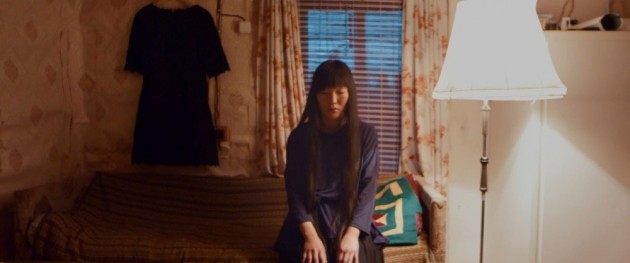
My Murderer
Part of the phenomenon of what has come to be known as Sakhawood (in analogy of Hollywood and Bollywood), the film shares some of the auteur genre cinema traits, which since the late 1980s have become increasingly popular with small national cinemas, confronted with turbulent times. For example, the first Hong Kong Mafiosi Thrillers, John Woo’s A Better Tomorrow I and II (Ying hung boon sik, 1986 and 1987) and The Killer (Dip huet seung hung, 1989), reflected the crisis of masculinity, triggered by the social anxiety from the impending handover to China in 1997—when the ‘best were either dead or have left the country’. 15 And, as has already been discussed above as well as elsewhere, 16 in Russia and in Poland (most notably Wladyslaw Pasikowski’s Dogs/ Psy, 1992), while the Mafiosi Thriller emerged after the collapse of communism due to similar reasons, the crisis of masculinity transcended its confines to become a subject of a much wider array of genre and auteur approaches. My Killer, on the other hand, reflects on the social anxiety brought on by the newly found pleasures of consumerist society and its clash with traditional local values, through the prism of a family tragedy, where the young heroine kills her twin sister for money. The film does however flaunt the characteristic Mafiosi Thriller devices – long and empty shots and voice over narration – along with Film Noir psychological deviance and existential musings, which make up amply for the unaffordable production values.
One of the most interesting post-screening discussion was with director Marsan and producer Marianna Skrybkyna, who – in addition to speaking about the making of this enigmatic film in the unimaginably vast expanses of the Russian North – showed a very promising trailer of their new film. This forthcoming mystical horror story, based on indigenous Sakha (Yakutian) folklore motifs, definitely deserves anticipating, along with any and all future developments in Sakhawood.
Postcommunist Auteur Existentialism and Families in Crises
The protagonists of the three internationally most successful works, shown at the colloquium – Closeness (Теснота, Kantemir Balagov, 2017), Arrhythmia (Аритмия, Boris Khlebnikov, 2017), and of How Victor ‘The Garlic’ Took Alexey ‘The Stud’ to the Nursing Home (Как Витька Чеснок вез Леху Штыря в дом инвалидов, Aleksandre Khant, 2017) – follow a psychological trajectory, which is propelled by separation from their immediate world, and conclude it with confronting their inner selves. And while society and historical circumstance – with their sometimes-despicable cruelty – are an intrinsic part of the narrative, the focus of the films is on the characters’ moral stamina.
These three films fall into the unique brand of postcommunist auteur existentialism, which informs the continuous success of the New Romanian Cinema over the last decade or so. As has been discussed elsewhere, 17 “the austere narrative formats [of New Romanian Cinema], reinforced by the archetypal structure of myth, account for its metaphysical integrity, where contents, form, and ethics merge into the compact entity of a philosophical proposition as a ‘truth bearer’, not unlike [Ludwig] Wittgenstein’s, which he considered to be a “picture of reality”. 18 Indeed, as A. O. Scott suggests, the inspiration for “the new type of realism of New Romanian Cinema seems to be as much ethical as it is aesthetic; less a matter of verisimilitude than of honesty”. 19 Not surprisingly, then, the foremost Romanian director Cristi Puiu – who, by quoting the father of general semantics A. Korzybski dismisses generalizations about his oeuvre as “describing the map, but not the territory” – strongly agrees that Wittgenstein’s proposition “ethics and aesthetics are one” captures the essence not only of his films but of the New Romanian Cinema as a whole. 20
This postcommunist existentialism is understood not only in its philosophical sense – that is, related to the loneliness and anxiety that come with the burden of one’s responsible moral choices – but also as a specific kind of realist aesthetics, which privileges the huis clos of psychologically detailed observation of human interactions, yet avoids the temptations of miserabilism or chernukha (in Russian). 21 As Puiu has sarcastically put it, the infantilizing aesthetic tropes of miserabilism/ chernukha have lost to a large extent their attractiveness as successful “festival survival tactics”, a “marketing tool”, comparable to “the Hollywood CGIs”, but “only much cheaper”. 22 It is not without a reason that specialists of postcommunist cinema and culture increasingly tend to define miserabilist cinema as a form of “self-colonizing” 23 or “self-exoticizing”, pointing to the fact that in this type of cinema, “the post-socialist region is epitomized as the wild borderland of Europe”, where “social-ethical standards are blurred”. 24 Fortunately, the ‘self-colonizing’ cinematic misrebilia is being ever more marginalized by works, which demonstrate the increasingly sobering realization that the West is facing its own real problems, and – to paraphrase the Soviet humorists Ilya Ilf & Evgeny Petrov – the problems of the postcommunist East are problems of the postcommunist East, and that is that. 25
Both Arrhythmia, Khlebnikov’s tenth film, and Closeness – a debut work for most of its cast and crew, supervised and produced by the celebrated Aleksandre Sokurov – belong to the best specimen of this postcommunist existentialist trend, and feature protagonists who are able to preserve their human integrity in the face of tough day-to-day existence. Like the personages from Greek tragedies, the married couple in the former and the main heroine in the latter, are in exposed position, yet not because of elevated social standing, physical beauty, or least of all – excessive arrogance or hubris, which provoked the ire of the Gods and destroyed their ancient counterparts. The tragic guilt, or hamartia that makes these personages vulnerable amidst the ubiquitous indifference, egotism and violence – lies with their rare, self-sacrificial sense of empathy for the suffering ‘other’. Thus, with her mixture of tom-boyish audacity and feminine charm, Ila from Closeness (in the amazingly passionate interpretation of Darya Zhovnar) almost immediately arouses pity and fear. She somehow miraculously manages to be a good daughter to her dotting parents, as well as her own daring person, which seems next to impossible in Nalchik, 26 a hotbed of virulent misogyny and bigotry circa 1998, the year the story takes place. Thus in addition to being almost as good a car mechanic as her father, Ila dares her closely knit Jewish community by rejecting an arranged marriage to the quietly considerate Moshe, because she is already in love with the burly Zelim, a local Muslim guy. And although we never see his face, he turns out to be good and caring, albeit always somewhat embarrassed by the candid intensity of Ila’s feelings. All the more that his friends – who happen to admire watching videos of Chechen terrorists killing in a most gruesome way Russian soldiers on the battlefield—are openly anti-Semitic. 27
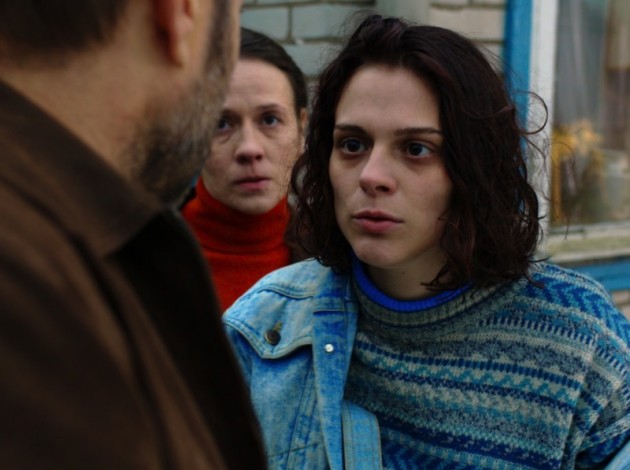
Closeness
The rising tensions both within and without Ila’s home reach their climax when her brother David and his fiancée are kidnapped on the night of their betrothal. Her father sells his body shop in order to pay the ransom, however it is thanks to Ila’s intervention by way of Zelim that the hostages are freed. And yet, although vehemently opposed to conceding defeat and moving with relatives in Western Russia, at the last-minute Ila resolutely boards the small overloaded car, and departs with her devastated parents. The dénouement literally takes the film from the grip of what Aristotle calls “particulars of history” – that is, the details of the suffocating narrative so far – to the heights of the Caucasian Mountains, as a breathtaking simile for the “universals of poetry”, which the ancient sage believed to be solely capable of reflecting on the redemption of human suffering through (self) sacrifice. The film ends with a close-up on Ila’s beautiful eyes looking at us in askance.
The self-sacrificial trajectory of husband and wife in Arrhythmia, which takes them through similarly unsettling chaos and anxiety, could be compared to what in arts and literature is known as ‘imitation of Christ’– that is, the choice of suffering in the name of others as a personal existential path. Although this choice seems to be inscribed in their professions – a doctor and a nurse – it eventually becomes a veritable Via Dolorosa, which brings their personal relationship to a breaking point.
The film reveals the day-to-day struggles Oleg (in the finely understated performance of Aleksandr Yatsenko) – a talented and devoted paramedic – wages with bureaucracy, insensitivity, and sheer laziness. And while his ultimate professional commitment and unwavering ethics put him in an exposed position vis-à-vis the new bullish hospital administrator, it is his gentle nature which – in a truly tragic fashion – makes him a reluctant hero, who is unable, or rather unwilling, to aggressively stand his ground. This inability to strike the right balance between life and work, is his hamartia, which predictably leads to erosion of his relationship with his wife Katya (an equally refined Irina Gorbacheva).

Arrythmia
In a truly dialogical (Bakhtinian) fashion, Khlebnikov switches back and forth between Oleg’s and Katya’s truths, making us privy to their subjective feelings and points of view. Although there is some evidence that Katya is also a devoted professional, she mostly comes through as person in emotional crisis, torn between her love for Oleg and a growing frustration with what she sees as his drifting away from her. And while Oleg’s emotional and psychological states are externalized – he binge-drinks, sleeps on the kitchen floor and, after a particularly nasty fight, spends the cold night in a shed – hers are masterfully internalized by Gorbacheva, who literally acts with her eyes and fragile presence. A master of psychological nuance himself, Khlebnikov makes almost palpable their anguish, as well as their impossibly hard – gesture by gesture, word by word, touch by touch – way back to each other.
It is impossible not to compare Katya and Oleg to another famous cinematic couple from current Russian cinema – that of Zhenya (Maryana Spivak) and Boris (Aleksey Rozin) from Andrey Zvyagintsev’s Oscar nominated Loveless (Нелюбовь, 2017). The egotism of Zhenya and Boris is so blinding that they fail to notice the fatal disappearance of their 12-year-old son Ayosha. As was pointed out at the Colloquium, Khlebnikov and Zvyagintsev have been moving through their careers – launched in the same year – as yin and yang, or – in the words of Carl Gustav Jung – as the two sides of an archetype. Indeed, their very first films – Road to Koktebel (Коктебел), co-directed in 2003 by Khlebnikov and Aleksey Popogrebsky, and Zvyagintsev’s The Return (Возвращение, 2003) – featured an always already complicated relationship between a father and his teenage son (or sons as in The Return). Thus Khlebnikov/ Popogrebsky look at this relationship through the prism of a buildungs roman, where an adolescent boy quickly matures during a road trip he embarks on with his father. And follow how, in the boy’s eyes, the father turns from an ideal, God-like figure into a vulnerable and fallible human being, which seems to be the only way the boy could mature as his own person, and reach the originally planned destination, metaphorically epitomized by the seaside town of Koktebel.
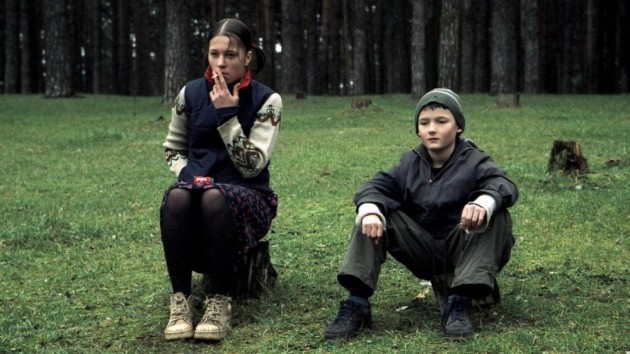
Road to Koktebel
Moreover, despite the grim sights and the harshness of the adventures in Koktebel, the free style camera and medium to long shots imply a feeling of lightness. In The Return, on the other hand, the master of the saturnine Zvyagintsev has his film shot as a series of elegantly lit minimalist tableaux, with gorgeously sculpted figures which – thanks to Mikhail Krichman’s camera – would become his visual style of choice. The Father here is an archetypal Senex 28 , representative of the rigidified, authoritarian paternalistic power, usually associated with the Soviet past. After an unexplained twelve years of absence – a more than transparent hint at the early years of Putin’s Thermidor (or Restoration, depending on one’s viewpoint) – the Father immediately embarks on disciplining his young sons by taking them on a men-only hike, and away from the emasculating influence of their mother and grandmother. His increasingly punitive attempts to make up summarily for the lost time however end up abruptly when the sons accidently, but unremorsefully, kill him.
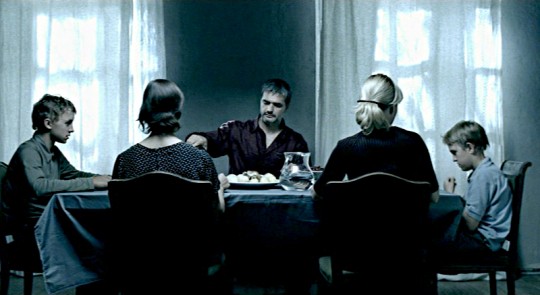
The Return
Again, unlike Khlebnikov, whose subsequent films draw their vitality from well-defined characters, immersed in the messy particulars of history, in The Return, Zvyagintsev establishes his signature narrative preference for a universal plot – or rather archetypally abstract psychological casus – around which he builds his characters, and then taciturnly steers towards the inevitable final catastrophe. And thus, while Khlebnikov leads the viewers through pity and fear to cathartic identification and compassion for the ‘human, all too human’ frailties of his characters, Zvyagintsev’s insists on approaching his characters analytically, as both victims and accomplices of their socio-political realties, and therefore unworthy of empathy.
Existentialism of the Absurd and the Grotesque
The existentialist absurdity and futility of life, the indifference of the universe, accompanied with the necessity of engagement in a just cause, has long since made its way into the theatre of absurd. Khant’s debut How Victor ‘The Garlic’ Took Alexey ‘The Stud’ to the Nursing Home, as its unusual title suggests, successfully does its best to circumvent both the analytical and the misreabilist trends of postcommunist and post-Soviet cinema, by creating a unique hybrid between postcommunist existentialism, and the absurd and the grotesque. As far as the post-Soviet Russian cinema is concerned, Khant’s film does hover on the edges, considered reserved for Kira Muratova’s oeuvre since the early 1990s, but is most closely related to Balabanov’s hilarious pastiche Blind Man’s Bluff (Жмурки, 2005), with which the late director all but put an end to the Russian version of the Mafiosi Thriller he had so successfully propelled in the 1990s with the Brother films. And while Balabanov has his New Russian Mafiosi drown each other in blood – the graphic violence of Blind’s Man Bluff, in its turn, represents a throwback to the macabre satire Outskirts (Окраина, 1998), the first and only film by Pyotr Lutsik (1960-2000) – Khant’s protagonist deals with the farfetched psychological consequences of the wild 1990s, epitomized by his father, the eponymous Alexey ‘The Stud’, a former ruthless Mafiosi now helplessly stuck in a wheelchair. The link to Blind Man’s Bluff is further secured by Aleksey Serebryakov, the golden boy of Russian cinema from the 1990s and the early 2000s, who plays the once glorious Stud with ironic self-reflexivity. The 27-year-old Victor (in the delicious over-the-top interpretation of Evgeniy Tkachuk) has always considered himself an orphan, and is far from thrilled when all of a sudden, The Stud re-emerges in his life. Yet still, albeit reluctantly, he takes him on the road to look for a place where the ‘old’ man could spend the rest of his days comfortably and in peace. Their road trip is actually a vivid and volatile – part realistic, part phantasmagoric, and part sentimental – journey into the past of The Stud, where Victor meets his friends, enemies, his second wife, who now lives in sprawling mansion with Victor’s half-sister, and gets involved in all kinds of adventures, some of them hilarious, other sad, and some even downright life-threatening. Thus, under the sounds of an intense Russian rap, the two of them embark on that tortuous archetypal journey of father and son towards each other, at the end of which the father should be either abandoned or dead, while the son – if his character buildung was successful – would have matured enough to shed his childishness and face the existential burden of infinite choices.
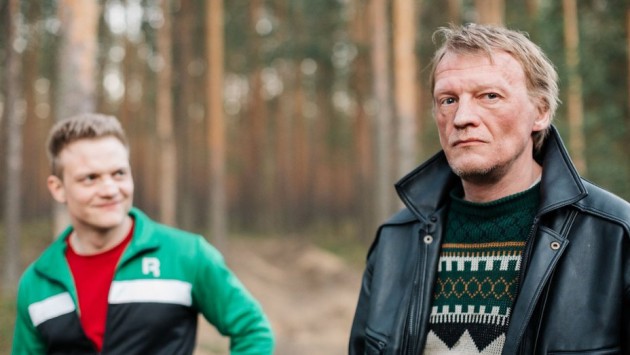
Victor ‘The Garlic’
True to his absurdist style, however, Khant opts for a third, and least expected resolution, which under different aesthetic regime would have looked either tackily melodramatic or irritably didactic. And has Victor, already half way back home, turn around his vehicle to pick up The Stud from the nursing home where he had just left him, thus consciously completing the otherwise serendipitous trajectory of the self-sacrificial son. Moreover, thanks to its uniquely postmodern comics-style narrative, and the aesthetics of free-flying incongruities and colourful paysages, the finale turns into an allegoric coming to terms with the traumatic heritage of the much disdained 1990s.
As has rightfully been noted at the Colloquium, Yusup Razykov’s film Sella Turcica is reminiscent of The Lives of Others (Das Leben der Anderen, Florian Henckel von Donnersmarck, Germany, 2006), but – it should be added – the resemblance is like an image in a black mirror, reflecting back only the malevolence of its protagonist, the former secret service agent Ilych. And none of his East German counterpart’s better self, which gradually emerges in Von Donnersmarck’s film.
The title of the film signifies Ilych’s medical condition in Latin, but also creates a perceptual grid, which explains his deeply troubled rapport with his environment. It is through Ilych’s skewed POV – through the remarkably organic facilitation of Valery Maslov – that the viewer grasps the contours of the idiosyncratic world Ilych inhabits. Which is far from a pretty sight, yet we are left in the dark whether this is the objective truth about the people who he – true to his former habits – trails, or is a projection of his professional paranoia, enhanced by his condition. Thus the boy and the girl that seem so in love actually turn out to be porn stars; a man who is about to kill himself turns to be a criminal, etc. All the more that the colour scheme keeps alternating between monochromic to colour, which rhymes with Ilych’s shifting state of mind, and additionally disorients the viewer.
This collapsing of boundaries – between real and imaginary, self and other, reality and illusion – which is typical of the horror genre cinema aesthetics, was taken further by the masters of the postcommunist Social Horror film – first by Lutsik, then by Balabanov, and currently by Sergey Loznitsa – who have additionally identified as “powerful sources of horror the collapsing boundaries between the collective and the individual, capitalism and socialism, the old and the new”. 29 Indeed, “In a paradoxical reversal of post-Communist loyalties,” in these films “the source of the uncanny … is the tension between the ‘new’ Russian way of life and the ‘old’ Soviet one”. 30
In Sella Turcica, the collapse of these boundaries is reflected in the absurdism of Ilych’s day to day existence, caught in between the old Soviet values he is clinging to, and his inability to understand the changed world around him. Not unlike Captain Zhurov from Balabanov’s Cargo 200 (2007), Ilych lives with the rotting corpse of the Soviet regime, epitomized by his former bosses, but mostly by his unrepentant weltanschauung. Therefore the inherently absurdist tensions – in both their philosophical irresolvablility and aesthetic incongruity –between his newly found passion for baroque opera arias and his primeval homophobia, lead him to murder, which is carefully cleaned up by his former secret services buddies. Yet the ambiguity of Ilych’s final tearful break down – provoked by his realization that the beautiful alto female voice he has fallen in love with, does not belong to his pretty young neighbour but to her boyfriend, a bisexual counter-tenor, whom Ilych had accidentally killed in a stairwell scuffle after seeing him kissing a male lover – has been interpreted by some as a demure sign of a positive turn towards accepting the changing world.
The skillfully sustained ambiguity by both director and actor make this otherwise simple and low budget work a veritable tour-de-force, especially within a climate, where people of Ilych’s ilk would go any length to find signs of illegal homoerotic propaganda. Yet Stella Turcica has clearly found viewers outside the festival chain as well, since it throws in high relief the overall tendency of contemporary Russian cinema to examine the path towards individuation and personal responsibility, undertaken even by such unlikely types like Ilych.
Coda: The Forgotten Delights of Surrealism
Among the works discussed so far, Rustam Khamdamov’s film Bottomless Bag (Мешок без дна, 2017) is a stand-alone gem, a rarity even among the scantly populated territory of the Soviet-Russian cinematic surrealism, harking back to such deliciously executed satires, inspired by Russian folkloric motifs like Aleksandre Medvedkin’s Happiness (Cчастье, 1935), or Viy or Spirit of Evil (Вий, 1967, directed by Konstantin Ershov and Georgiy Kropachyov). And although Bottomless Bag is way too delicate and sophisticated for their socially acerbic humour, on certain levels it could still be linked to Aleksandre Ptushko’s famous renditions of Russian fairy tales, made in the fantasy genre between the late 1920s through the early 1970s. Yet Khamdamov’s film remains uniquely postmodern in its defiant eclecticism, which the director elegantly interweaves within a complex structural frame, evocative of surrealist auteur cinema. In fact, Bottomless Bag belongs to a league of Khamdamov’s own, consisting of only five other titles, made between 1967 and 2011, whose style could aptly be defined as a surrealist intermediality for esthetes. In three of these works, the film medium takes upon itself the role of a frame, encasing portraits of divas – from the silent cinema era and from the opera. Due to the unusual calamities, which have haunted the completion of these works, Khamdamov has turned to drawing and production design, but has also made a couple of shorts, focusing – significantly – on precious stones. On the backdrop of such an intricate cinematic career, the hard-won success of Bottomless Bag looks all the more deserved and valuable.
The role of the Narrator, played by the gorgeous-looking late Soviet actress Svetlana Nemolyaeva (b. 1937), is pivotal for the Russian dolls’ structure of the film. A middle-aged lady-in-waiting in an imaginary Russian court, the Narrator – in a Scheherazade-like fashion – is trying to distract her grief-stricken master, the recently widowed Grand Duke, from descending into depression and alcoholism. Most of her stories are oneiric improvisations, which mix and match narrative motifs, characters and images, taken from Russian fairy tales, classical Russian literature, and even from Japanese literature and cinema. Which an imperial lady-in-waiting from historical Russia could have had no knowledge of! And in this, the film is strongly reminiscent of the ethereal metaphysics of the guided tour through the times and history of the Hermitage, offered by Aleksandre Sokurov’s Russian Ark (Русский ковчег, 2002). All the more that the Narrator’s wild fantasy is forcefully matched by the stunning visuals of the film, which hark back to some of the best cinematic works from the black & white era.
The centre-piece of the film – and the Narrator’s masterpiece – is interwoven within the narrative canvas of Ryūnosuke Akutagawa’s famous story In a Grove (1922), while the camerawork by Pyotr Dukhovskoy and Tim Lobov conjures the mythic atmosphere of its brilliant cinematic rendition by Akira Kurosawa in Rashōmon (1950), with its signature images of a spring forest, shot through with sunlight. It is in such a forest, where the proverbial several versions are played out of what ‘really’ happens with the bewitched Tzarevna (the Princess), while the Tzarevitch (the Prince) is tied to a tree, and what is the role in this of the wicked Baba Yaga (the old forest witch), and of other floral and faunal creatures from the Russian folklore. The surrealist bent of the film is ironically thrown in high relief by the Grand Duke, who becomes increasingly aware of the liberties the Narrator takes with the originals, and gets to correct her more and more often. And thus alerts the viewer to the multiple layers, contained in this bottomless bag of stunningly beautiful and dreamlike folkloric, literary, and cinematic riddles, the cracking of which makes the film ever more delightful.
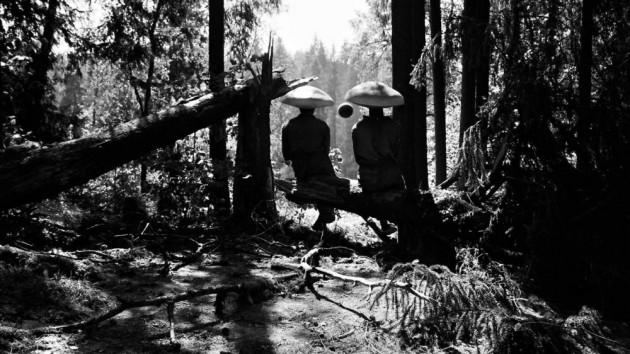
Bottomless Bag
In conclusion, on the basis of the Colloquium film selection, one could say that the new Russian cinema is turning with growing confidence towards its viewer, experimenting with various narrative and aesthetic approaches, ranging from the mainstream genre cinema to auteur existentialist and analytical works, to experimental films, pushing the limits of expression into territories where the Soviet and Russian cinema has rarely treaded before. Indeed, as Vodolazkin – to quote him again – says, truly experimental – and postmodern – works stand the danger to be compared to a frame without the portrait. 31 That is, could be dismissed as abundance of form at the expense of what the ancient Greeks called εἶδος, a central idea or meaning. And yet while the forays of Khant and Razykov into the absurd and the grotesque could be explained with the need for emotional or political subtlety, Khamdamov’s film is a rare example of how the richness of the frame – immersed in the boundless beauty of literature, cinema, and myth – becomes a most expressive conduit of the fundamental εἶδος of true art – the meaning of life. And thus the growing aesthetic and genre diversity of new Russian cinema enables it not only to highlight the particulars of history – its horrors, its deficiencies, its misery – but to also throw in high relief the universal beauty of human bravery and self-sacrifice in the face of existential nothingness. In this line of thought, Vodolazkin – following the existentialists – suggests that there is a direct link between people’s ability to find their own meaning in life, their personal moral responsibility, and democracy. 32
FIPRESCI at St. Petersberg
Feature header photo from Sella Turcica
Notes
- Kosciejew, Richard John, The Treadmills of Time, AuthorHouse, 2014., p 143 ↩
- The notion of ‘art for the masses’, at least by definition, is profoundly democratic, and ideologically opposite to the concept of ‘mass art’. For one, the former suggests that traditional – considered sometimes highbrow and elitist – arts should be made accessible to the masses, while the latter implies creating a new brand of art, targeting the masses ↩
- Stojanova, Christina. “The New Russian Cinema”, in Kinema No.10 (Fall 1998), at Visited March 2018. ↩
- This hybrid auteur-genre approach quite successfully served also the so called Putin’s cinema from the early 2000s, where films like Pavel Chukhray’s A Driver For Vera (Водитель для Веры, 2004) and Dmitry Meskhiev’s Our Own (Свои, 2004) appeal to a rehabilitation of unpleasant pages of Soviet history, or more specifically, of “the formidable KGB officers and the Party Commissars”. Yet, as has been said elsewhere, if “Russia is to survive in the new millennium, the subtle message [of these films] goes, people have to learn to empathise even with the bad boys for “we all are family”, as one of the characters in Our Own proclaims at the film’s finale”. Stojanova, Christina. “The Russian Cinema at the Beginning of the New Millennium”, in Kinema No. 24 (Fall 2005). Visited March 2018. ↩
- Ibid. ↩
- Stojanova, Christina. “Mise-en-scenes of the Impossible: Soviet and Russian Horror Films,” p. 104, in Alternative Europe: Eurotrash and Exploitation Cinema Since 1945, X. Mendik, E. Mathijs, Eds.,Wallflower, UK /Columbia U Press, USA, 2005, pp. 90-105. ↩
- Vodolazkin, Evgeny. Home and Island, or the Tool of Language (Дом и остров, или Инструмент языка), АCT Publishing House, Moscow, 2016., pp. 349-377. ↩
- The production budget of the film was (according to Wikipedia), 814 million rubles, and the box office about 512 million (Dec 2017). Due to overreaction on behalf of ultra-religious pundits, who insisted that the recently canonized as saint emperor should not be shown in such a ‘demeaning’ light, “the planned release of the film has become the subject of a public conflict” as early as Nov 2016. There was “fierce controversy, attempts to ban the film, threats to film distributors and arson in one film theatre” wikipedia. Visited January 2018. ↩
- Budget 380 million rubbles, box office – over 1 billion rubbles. ↩
- Budget 400 million rubbles, box office 748 million rubbles. ↩
- Socialist Realism was proclaimed as ‘official aesthetics’ of Soviet arts in 1934, at the First Congress of the Soviet Writers. During that congress, the following four main principles were established. The art works must be 1) Proletarian: art relevant to the workers and understandable to them; 2) Typical: scenes of everyday life of the people; 3) Realistic: in the representational sense; 4) Partisan: supportive of the aims of the State and the Party (Juraga, Dubravka and Booker, Keith M. Socialist Cultures East and West. Praeger, 2002), p.68. ↩
- Such a movement from ignorance to knowledge, which usually happens under the influence of a Mentor, has been known as bildungs roman since 19th century, but gained popularity during the rapidly politicizing 1930s as ‘structure of apprenticeship’. The nature of this ‘apprenticeship’ – whether ‘positive’ or ‘negative’ – is determined by the overall ideological context, whose powerful agent the Mentor is. Thus the ultimate fate of the character depends on the ‘real’ or ‘false’ nature of the knowledge, imparted by the Mentor who, in his or her turn, could lead the character to either ascendance or demise. It is enough to recall Luke Skywalker’s positive apprenticeship under Obi-Wan Kenobi’s and Yoda’s guidance, but also the potential of a very negative one if he were to follow Darth Vader. In fact, the shifts in the social, ideological, and geo-political climate over the last century could be astutely mapped by registering the changes, undergone by the literary and cinematic Mentors worldwide. Stojanova, Christina. The Eastern European Crisis of Self-Knowledge (1948-1989): The Relationship Between State and Society as Reflected in Eastern European Film – A Genre Approach, Doctoral Dissertation, Montreal: Concordia University, 1999. ↩
- He is the discoverer of the so called Dzhanibekov’s effect. ↩
- The film was awarded the prestigious Golden Eagle, the Russian Best Film award (January, 2018) ↩
- Stringer, Julian. “‘Your Tender Smiles Give Me Strength’: Paradigms of Masculinity in John Woo’s A Better Tomorrow and The Killer.” Screen, v. 38, no. 1., Spring 1997., pp. 25-41. ↩
- Stojanova, Christina. “Le film de genre américain dans le cinema post-communiste: ‘le Mafiosi Thriller’”, in Ciné-bulles 17, No.2 (Été) Summer 1998, 38-43 ↩
- Stojanova, Christina. “Introduction”, in The New Romanian Cinema, C. Stojanova, Editor, Edinburgh University Press, 2018, in print, p. 15. ↩
- Quoted in Stojanova, 2018, p. 15. ↩
- Quoted in Stojanova, ibid. ↩
- Puiu, Cristi and Christina Stojanova, Interview, 2017. ↩
- The term was coined by Variety’s Eddy Cockrell with regard to Hungarian film Taxidermia, which he described as an ‘exercise in Central European ultra-miserabilism’. (Visited Feb 2018). ↩
- Puiu, Interview, 2017. ↩
- Coined by Bulgarian scholar Alexander Kiossev in 1999, the term signifies “a core of self- imposed, voluntary identification, formed by Eastern European nationalisms following the West’s image of the region” (qtd in Imre, 2014: 121). ↩
- (Strausz 2017: 243). ↩
- The awarding of the highest Locarno IFF awards to two Bulgarian films in quick succession reveals most eloquently the crisis of the misreabilist style. Thus, the 2016 Locarno IFF showered with Golden Leopards Godless (Безбог, Ralitza Petrova, Bulgaria) – an aesthetically substandard and ethically speculative work – reconfirming yet again that the raison d’etre of miserabilist cinema is ‘to let the West breathe a sigh of relief’, knowing that the ‘barbaric communities such films represent’ are ‘at a safe distance from the civilized and enlightened hubs of cultural exchange’ (Strausz, László. Hesitant Histories on the Romanian Screen, Palgrave-McMillan, 2017, p, 243). Yet only a year later, the Golden Leopard (Filmmakers of the Present) went to Ilya Metev’s ¾ Three-Quarters (Три-четвърти) – a pensive drama of a family on the eve of the daughter’s emigration to Germany. ↩
- The capital of the Kabardino-Balkar Republic (Russian Federation). ↩
- The story takes place between the First (1994-1996) and the Second (1990-2000) wars in the neighbouring Chechnya. ↩
- According to Jung, the Senex (the Old Man, Latin) and the Puer (the Boy, Latin) are the two sides of the same archetype. While the senex is “associated with the god Apollo – disciplined, controlled, responsible, rational, ordered”, the puer is related “to Dionysus – unbounded instinct, disorder, intoxication, whimsy”. Sharp, Daryl, Jungian Lexicon, Visited February 2018. ↩
- Stojanova, Christina. “Mise-en-scenes of the Impossible: Soviet and Russian Horror Films”,p. 104, in Alternative Europe: Eurotrash and Exploitation Cinema Since 1945, X. Mendik, E. Mathijs, Eds.,Wallflower, UK /Columbia U Press, USA, 2005, pp. 90-105. ↩
- Ibid. ↩
- Vodolazkin, Evgeny. Home and Island, or the Tool of Language (Дом и остров, или Инструмент языка), АCT Publishing House, Moscow, 2016., pp. 349-377. ↩
- Ibid. ↩



